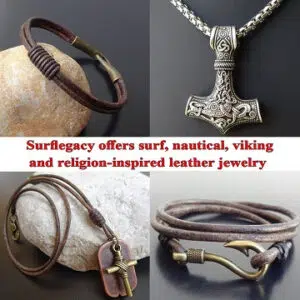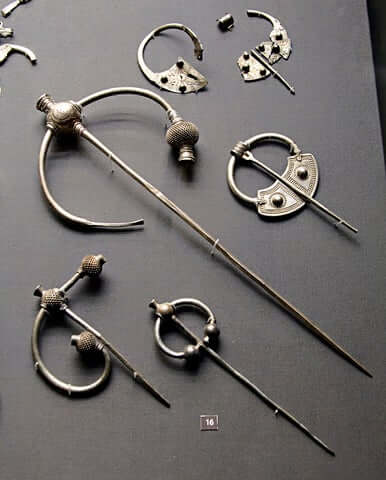Norse jewelry is very popular among us today. Its beautiful and unique look makes people stand out from the crowd. However, how much history do we know about it?
The history of Norse jewelry dates back to the Viking Age. At that time, the Vikings were known for their beautiful and intricate jewelry. They used a variety of materials to make their jewelry, including gold, silver, iron and bronze.
Norse jewelry was often decorated with animal motifs, such as dragons, wolves and crows. The Vikings also used symbols of their gods and goddesses on their jewelry. it was not only beautiful but also very practical. It was used to help the Vikings identify themselves and their families. It was also used as a form of currency, and passed down from generation to generation. This is because it was so valuable. Today, you can find Norse jewelry in many different places. You can find it in museums, online, and in stores that sell Viking products.
Why Do People Wear Norse Jewelry?
There are many reasons why people might choose to wear this kind of jewelry. Some might be interested in Norse mythology and the history behind it, while others may be Viking enthusiasts who enjoy collecting artifacts and pieces of jewelry from the era.
Many of these Viking jewelry artifacts are made of silver and bronze, and their reproduction can be quite expensive. For those who appreciate the beauty and symbolism of Nordic Jewelry, it can be a very special way to connect with their heritage and Viking culture.
Uncovering The History Of Norse Jewelry
Jewelry was made of metals such as bronze, silver, gold, gems and precious stones, but also of simpler materials such as wood or glass. The Vikings, raiding and trading, had a wide range of possibilities to come into possession of these raw materials, useful, therefore, as well as for other contingencies, for the production of jewelry.
The Nordic People were able to take advantage of these goods for the production of precious jewelry and luxury goods both in the settlements created outside Scandinavia (especially in the British Isles), but also in the motherland. The importance of these events for the production of Jewelry can easily be understood when one considers the countless raids that the Vikings organized across Europe against the monasteries of the continent.
Looting was of course also committed against entire cities, But these men and women were able to get rich and possess raw materials and precious metals also through less violent and more legal methods: let’s talk about commercial activities, in which, as mentioned, the Vikings were particularly skilled, thanks to their navigation skills, which brought them to the most prosperous and rich markets of the world (such as those in the East), but also thanks to the trade bases present in the motherland.
Another important feature to highlight, proper to the Viking world, is that which concerns the religious history of these people: it is clear that even in the jewelry we see a representation and a testimony of the religion of these people, the Norse one, therefore finding numerous symbols and images of their gods and everything that belonged to their world.
But, during the eleventh century, began a definitive process of assimilation to the Christian religion of the entire Scandinavian universe, which therefore had important consequences even on the appearance of their jewelry: from this moment on, in fact, Christian elements begin to appear more and more, gradually going to replace the pagan ones.
Most of the jewelry of the Viking Age comes from archaeological sources: excavations of burial sites, commercial centers of the Scandinavian world, accidental findings of Viking objects in other parts of the world or objects resurfaced from water, but especially the findings made in the graves, are our most important sources for this type of findings.
What Is Norse Jewelry Made Of?
Most of these Viking Jewelry objects were made from more durable materials, such as metals (precious and not), amber, glass, but also wood, ivory (in this case from the tusks of the walrus) and bones. For Viking artists, wood was by far the preferred raw material, due to its ease of carving, low cost, and abundance in northern Europe.
As for metal, this is the material of which most of the jewelry that has been found is made, so studies are mainly based on this type of material. Bronze iron and silver were still the main materials used for nordic jewelry, the latter sometimes gilded, but there have also been artifacts found that were entire of gold, either in individual pieces or sets, which probably belonged to the wealthy Vikings.
The jewelry was worn by both men and women, of all social classes; they wore brooches, necklaces, rings and bracelets. These items obviously had an ornamental and practical function (such as brooches, which were used to fasten clothes), but they could also indicate the state of well-being of these people. In addition, there were some pieces that had a particular symbolic value, such as all those jewels that bore a religious representation (most immediate example Thor’s hammer pendant ).
Married women tied their surcoats close to their shoulders with a pair of wide matching brooches (today modern scholars call these brooches “turtle brooches” because of their domed shape). The shape and style of these brooches vary from region to region, but the fretwork is common in many of them. Between these two brooches, most often, women strung chains or strands of beads, or dangling ornaments.
Men wore arm rings, bracelets, and necklaces, and fastened their coats with fibulae or, often, with peculiar, long pins. As for the decorations, jewelry was adorned with geometric designs, braided bands, figures and heads of animals and beasts, religious elements and symbols, but also with depictions of the everyday world.
What Type of Nordic Jewelry did Men Wear?
Nordic jewelry for men was often made of simple metals like iron, copper, and bronze. The most common type of jewelry worn by men was a neck ring or torcs. These were made of either a single metal wire or multiple strands twisted together. Other popular pieces of jewelry included arm rings, brooches, and beads.
What Type of Nordic Jewelry Did Women Wear?
Nordic women have a rich history of adorning themselves with jewelry. While there were many types and styles of jewelry worn at different times, some pieces were more common than others. Earrings, necklaces, bracelets, and rings were all popular pieces of Nordic jewelry. Many of the designs were inspired by nature, with intricate patterns featuring leaves, vines, and other flora. Some pieces were also made from precious metals and stones, such as gold and amber.
Where Can I Purchase Viking Jewelry?
There are many places where you can shop for Viking products. Online store Surflegacy, is your premier destination for high-quality handmade Jewelry. If you are looking for some beautiful Viking bracelets, Viking Necklaces, or Viking Rings and have gone through dozen of websites in search of the ideal design and price range, then you have come to the right place.
Finding low-priced quality Viking jewelry is not easy, this is the reason why our Vegvisir pendant, Viking axe pendant, Thor’s hammer stainless steel necklace, or Viking charms like Fenrir and the Raven are in high demand.
Our unique jewelry is crafted in Europe, with care, and style in mind; our main goal is to provide the best possible customer service and order experience to buyers. For more handcrafted Norse jewelry and Viking jewelry for sale, visit our collection HERE we add new products every month.
We offer Worldwide shipping, for your peace of mind all payments with Visa, Mastercard, and Paypal are secured by Sectigo 256-bit encryption. Orders are usually posted out within 1 or 2 business days and when you spend over 60 usd (not including shipping) you get free shipping too.



